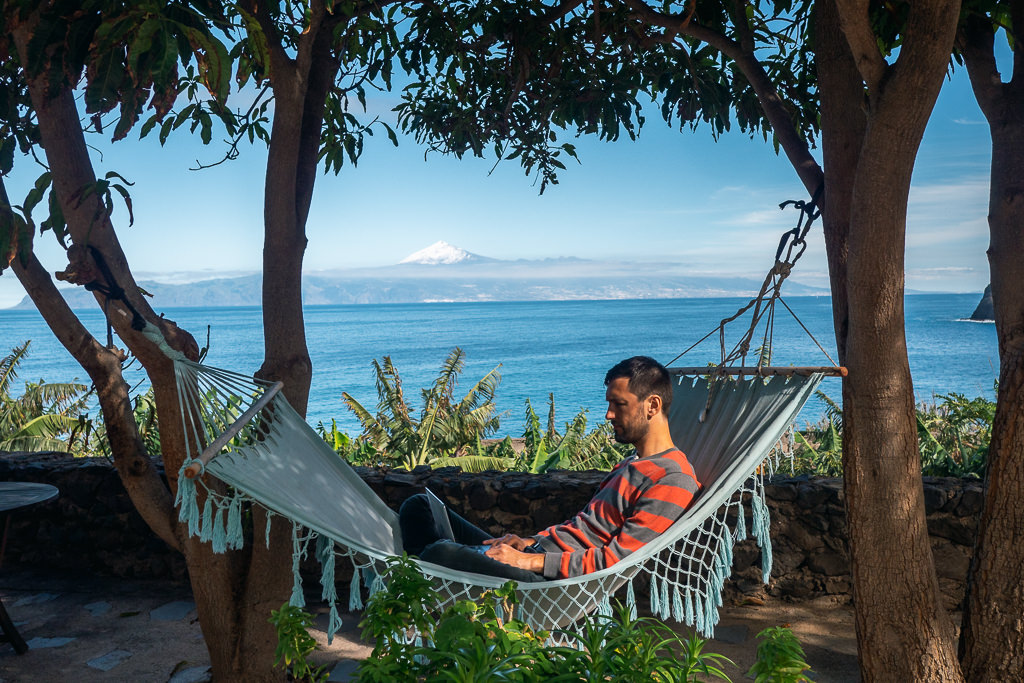Who said working remotely is something you can only do from home? If you’re thinking of a remote work escape or maybe even dreaming of hitting the road as a digital nomad, then I have some very useful tips for you.
I’ve been working online since 2012 (yep, when this was still a novelty) and have learned a thing or two. But I also love to travel just for travel’s sake without packing a laptop, so I’ll be coming at this topic from a few different angles.
First, I’ll share some thoughts on whether working remotely is necessarily the right way to go. Then, I’ll get into the practical, technical, and legal aspects of how to do it.
Working remotely vs. sabattical
This blog is aimed mostly at long-term travellers, though if you stumbled upon this page via Google then your remote-working ambitious could really be anything…
Maybe you’d like to escape for a week or two within your own country, maybe you’re thinking of going abroad for a month, or perhaps you’re one of the hungry ones longing for a fully nomadic lifestyle.
I’ve personally done a bit of all of the above. To be honest, based on my own experiences and my interactions with digital nomads, I believe going on a travel sabattical can often be a lot better than working remotely while travelling.
So before we jump in, let’s consider if going remote is truly the right move.
Let me explain…
I see digital nomads broadly belonging to two categories:
- Working remotely for lifestyle reasons
- Working remotely specifically to travel
The nomads in the first category are usually the happiest. If the motivation is not so much to “see the world” but to live in a different place for a while (potentially in a low-cost country) with plenty of comforts and fun activities for the weekends, then there are fewer challenges involved.
You’ll need to build up a social circle in your (temporary) new home and there are some practical challenges I’ll cover in a moment, but maintaining a healthy work-life balance is so much easier when you’re not moving around.

Maybe you’d like to spend a few months living by the beach and surfing every day in Mexico or living a quiet life among the alpine meadows in the Bulgarian mountains. This can be an amazing life experience! And you will still have time for some local travel activities in your weekends.
But things get much tricker when your primary goal is to travel. If you’ve always dreamed of visiting more countries, doing lots of tourist activities, and ticking lots of items off your bucket list, then working remotely could enable you to do this — but it’ll be a lot harder. Unless you are well-prepared, you may end up disappointed by the compromises involved or end up suffering from travel burnout.
I’ve honestly always found it difficult to combine active travel (i.e. following an itinerary and doing lots of sightseeing) with ongoing remote work. My best travel experiences have actually always been when travelling just for travelling’s sake… without any work obligations getting in the way of adventure.
I think anyone who’s in the “I want to see the world!” category should carefully weigh the pros and cons of going the digital nomad route, or finding a way to pause work for a while in order to just travel.
I know the latter is not a practical option for everyone — and American work culture in particular highly discourages this — but I still believe travel sabatticals are seriously underrated. If you ever have any opportunity to take one, do it!
When you’re doing a 1 or 2 month travel break you can experience infinitely more than a digital nomad travelling for 6 months but always needing to find a desk, WiFi, and a comfortable base. You can truly go off the beaten path, go remote in a literal sense, and get into a spontaneous travel flow that is harder to capture when you’re simultaneously doing a 9-to-5.
I wrote a book about how you can travel more than just the typical average annual holiday! In Travel the World Without Worries, I discuss how to:
- Use different strategies to travel more; from regular trips to career breaks to remote work and travel jobs — and combinations of these
- Find the time and budget to realize your travel dreams based on different financial or practical situations
- Balancing work and travel in the best ways possible if you take your work on the road; or to have the most exciting off-the-grid adventures if you decide to leave the laptop at home!
Challenges vs. opportunities
Ever since the pandemic hurled remote working into the mainstream, the advantages have been much more widely appreciated, so I won’t have to go into too much detail here.
But while many have worked remotely from home, not everyone has taken their work on the road, so here are a few of the pros and cons…
Benefits:
- A chance to get away from your typical routine
- See more of the world without quitting your job or using up all your holidays
- New possibilities for avoiding dreaded commutes, spending time with loved ones abroad, and pursuing hobbies (at last… you can stay by the beach and go kite-surfing every day!)
- Cost arbitrage: you can earn an income from a high-income country while spending in a low-cost country
- Specifically for travelling: more opportunities to travel in the off season (fewer crowds and lower prices), to stay longer in places, and connect more with the local communities by travelling differently from the typical tourist
The level of freedom you can experience is amazing, but it does come with its own set of difficulties, which are not to be underestimated.

Challenges:
- Unless you work for yourself, you likely need employer and/or client approval
- You may end up being less connected or visible to your team, bosses, etc.
- It requires self-discipline and motivation to work from an exciting destination you have yet to explore. Potential distractions and FOMO are all around you!
- Practical issues abound such as travel costs, ensuring stable and reliable internet, plus various legal, tax, and technical implications to working remotely abroad (we’ll get into these below)
- Specifically for travelling: difficult to manage compromises between travel and work and to capture a ‘holiday feeling’. You can see and do much more on a regular trip/vacation than on a remote work trip.
To my mind the key challenge is really that travel and work don’t always mix very well! The desire to explore every corner of a new destination can seriously interfere with your productivity… and you can find yourself having some very un-fun late-night cramming sessions just to meet a deadline because you were too busy going on wine tours and swimming with dolphins.
So let’s look at how to make the nomad lifestyle best work for you — whether you’re planning a short remote work trip or dreaming of going around the world with a laptop under your arm.
10 Tips for working from anywhere
Ready to jump in? Then consider my practical tips to make it happen:
1. Check if your employer allows it
If you’re freelance, have your own business, or already work for a remote-friendly company then you may skip this section.
Otherwise, some tiptoeing may be advised here, as not every employer is so keen on employees working remotely — or at least, not from far-away locations.
Any geographic restrictions are typically for legal rather than purely practical reasons. Some companies are just not set up for it in terms of HR and employee management.
You may want to discuss with your employer what is acceptable within company policies, though some remote workers prefer not to tell. For instance, my partner works in a major multinational IT company, and while her direct manager knows of her remote work trips, there is a bit of a “grey zone” policy in the company overall — whether it’s allowed officially is unclear, however it’s tolerated in practice. Of course, it will be different for every company.
A common solution is to become a freelance contractor for your employer; that way any tax and legal compliance issues are yours to deal with, while the company simply receives your invoices.
I don’t necessarily recommend working remotely in secret, but if you do, make sure to hide your location (see the next tip). In any case, make sure you know your company’s IT policies; some prohibit using public WiFi or have special rules for handling confidential information outside the office.
If there is no way around it, perhaps it’s time to look for a fully remote job. Use sites such as RemoteOK, We Work Remotely, Working Nomads, and Remotive to find the ideal remote job for you.
2. Keep your location hidden (if necessary)
A few years ago during the pandemic, a friend of mine gave herself away when all of a sudden a colleague asked her to turn her video on… her background was the lush palm trees of Mexico. Oooops. This definitely got her into a bit of trouble!
Such situations are best avoided. While it’s best to be transparent with your employer, if you want to work remotely without them knowing, it’s crucial to hide your location.
No, blurring your Zoom background isn’t enough. Every internet connection has an IP address, which can be traced to a specific country or even city.
If you don’t take precautions, your employer can absolutely see if you’re logging in from abroad.

To keep your location hidden, it’s key to use a Virtual Private Network (VPN), which encrypts your internet connection and can mask the IP address.
For this you essentially have two options:
- Use a public VPN, like subscribing to NordVPN, for a basic level of concealment. A savvy IT department may detect that you’re using a VPN, but at least they won’t know where you are, so that would give you some nice “plausible deniability”.
- Use a private VPN (recommended). This lets you set up your connection so that it appears to be coming from your home or another trusted location. My recommended service for this is KeepYourHomeIP, which I have succesfully used myself.
The major advantage of using a private VPN is that you’re truly hidden and will appear as though you’re logging in from home. It will also still work properly even if your company already requires you to use a VPN.
Setting up a private VPN is quite complicated, but not with KeepyourhomeIP, which offers a no-worries service that involves just a 5-minute (non-technical) setup. They also offer amazing tech support should you end up having any issues with your connection while abroad. A travel router is included that lets you connect to any WiFi abroad and reroute it through your home connection.
I wrote about my experiences using KeepYourHomeIP here.
Check plans at Keepyourhomeip3. Start small — you don’t have to go fully nomadic
Based on social media it seems as if EVERYONE is taking working remotely to the extreme and becoming a year-round ‘digital nomad’.
But the beauty of working from wherever is that you can choose what kind of lifestyle you want. That could be by the poolside in Bali or from the comfort of your own home with your cat on your lap — or why not both?!
I’ve done the full-time nomad thing and given the right person and life circumstances, it can be truly amazing. It’s also quite a big step to take which keeps many people from doing it. That’s why I think part-time nomading is hugely underrated.
For instance, you can choose to escape the blistery winter months and go remote for a season.
Combining some remote working with a regular holiday is an incredibly underrated idea. You can acclimatize and work in the destination for a while before exploring as a tourist. You can fly in- and out at your own schedule, avoiding peak times for tourism such as Easter or Christmas.
If your remote work experiments go well, you can always go bigger.

4. Keep your costs under control
If you’re spending lavishly like you’re on holiday, your remote work trip could easily cost you more than you’re making on the job!
Remote work travel often requires more of a budget mindset for it to make sense. Luckily, there are many ways to reduce costs.
- Choose affordable destinations. Skip Paris, New York, and London and go to Da Nang, Cape Town, or Mexico City. Nomads.com and Numbeo offer great cost of living comparisons.
- Reduce overhead at home. Consider subletting your apartment or house while you’re away.
- Stay in one place longer. Avoid hotels and other places aimed at short-term stays. When you book accommodation for a month or more you are much more likely to get discounts. You can find more tips for finding work-friendly accommodation.
- Consider housesitting. With websites like Trusted Housesitters, you can mind someone’s home while they’re away. It costs $99 to sign up to Trusted Housesitters and get verified, but then you can stay in places entirely for free for a whole year — usually in exchange for watering the plants or feeding the pets. (If you use the links here, a 20% discount for Indie Traveller readers is automatically applied.)
- Avoid tourist high season. As a remote working traveler, you can grab off-season deals and discounts or fly at unpopular times during the week and make major savings on travel costs.
If you plan things well and especially by travelling in cheaper countries, it’s actually possible to have a lower overall cost of life by working remotely than by staying at home.
5. Understand the implications for visas/immigration
Depending on your home country, you may (officially) need to obtain a special visa or permit to work and/or travel in countries abroad.
To be honest, what many people do to avoid any sort of hassle with visas and immigration is to enter on a tourist visa… I mean, you are a tourist technically. In practice, this is how 95% of digital nomads travel and work, though the exact legality of it is a matter of dispute.
Just remember that if you’re travelling for work and you don’t have a work visa that can be a red flag for immigration officials.
Many countries have begun implementing digital nomad visas to incentivize people to come and stay in their country. These typically allow long stays during which you can work legally without paying taxes there (you simply continue to pay taxes wherever your tax residency is).
If you’re doing a housesitting assignment through a platform such as Trusted Housesitters, keep in mind this can be regarded as work by border control or immigration. Even though housesitting is done for free, in a legal sense it still counts as work (it’s ‘paid’ with free accommodation). That can mean being denied entry if you don’t have a work visa.
7. Bring the right gear
You’ll want to make sure you can work comfortably from anywhere. That means bringing reliable gear and a proper work set-up.
Besides my laptop, here are my must-haves:
- Travel Router for functions like tethering, running a VPN, or using it as a repeater (to expand the reach of a WiFi signal)
- VPN Service for secure and private connections
- Portable Hard Drive (SSD) so you’re not always reliant on the cloud
- Laptop Stand (Foldable & Compact) for better ergonomics working from cowork or Airbnb desks
- Universal Travel Adaptor & Charger to work with every plug type
- Portable power bank so you can work longer from cafes and other public places

8. Be 100% sure you can be connected
It’s absolutely critical that you can be online with a stable and reliable internet connection.
In my guide to finding remote-friendly accommodation, I discuss ways of checking if your Airbnb or hotel has a good enough internet connection.
Just to be sure, I recommend also having a local cellular data plan as a backup. Research the best data plans in your destination and make sure you know how to set up a hotspot so you can switch to mobile in a pinch. You can buy a portable hotspot that takes a data SIM card.
A small travel router can be a useful tool for staying connected as well. It will let you boost the range of the WiFi in your accommodation, which is sometimes necessary if you want the signal to reach all those fun working spots like the balcony, garden, or kitchen.
9. Get insurance if going abroad
If your employer provides health insurance, make sure to check if it covers you when outside of your home country (it usually doesn’t).
Travel insurance can be a solution, however it typically won’t cover longer trips and travel insurance plans aren’t optimized for the needs of a remote worker (and are typically more expensive as a result).
I recommend getting health and travel insurance geared towards digital nomads. This will give you peace of mind knowing that if something does happen, you’re covered.
My favorite nomad travel insurer is SafetyWing, which is specialized in affordable travel insurance for remote workers on an ongoing basis. It includes features such as long-term coverage, virtual doctor consultations, and other benefits.
Important: almost all “digital nomad visas” require that you have full health insurance coverage. This means insurance that is valid in the destination, not the insurance you might have in your home country.
10. Choose your destinations wisely
Not all remote working destinations are equal. Some can create a serious logistical and practical strain that will make it far more difficult to enjoy both the travel and work aspects.
I mean, good luck trying to upload a file using that dial-up modem in rural Bolivia… it will absolutely make you flee to somewhere else. (This is from personal experience! I tried being a nomad in Sucre for a while, but the connectivity was horrendous. I quickly decamped for Argentina.)
Many aspects that you won’t have to worry about as a tourist will matter a great deal if you’re working from there. It’s a good idea to research your destinations in terms of healthcare system, cost of living, and access to WiFi. My favorite site for this is Nomadlist, which allows you to filter destinations by pretty much any imaginable criteria.
There are some popular remote worker hubs around the world with major digital nomad communities. While maybe cliche choices, they can make for excellent starting points in your nomad journey. Some enduring favorites include Medellin in Colombia, Bangkok and Chiang Mai in Thailand, Canggu in Bali, Indonesia, and places like Mexico City and Puerto Escondido in Mexico.
Using remote work to travel differently
While staying productive on the road takes some practice, working from anywhere lets you travel in a truly different way.
You can stay far longer in known tourist hotspots than a typical vacation and try having a mini-life there. Or you can take chances on destinations you might not have otherwise considered. A month in Genoa can teach you more about Italy than that 3 day vacation in Venice.
Perhaps you could stay in a small village in rural Greece. Or maybe work from a surfer beach in Indonesia. Or maybe skip the capital but hit up the second or third city in a country, which are often amazing for getting a taste of the local life while still having a high level of comfort. The possibilities are endless and definitely don’t end at the typical digital nomad hubs like Lisbon or Bali.
One thing I highly recommend is to slow down!
Constantly moving location, as you might on a normal trip, can be a real productivity killer — and it will drain your energy, causing both your work and travel to suffer. Rather than packing and unpacking constantly, it often makes sense to stay in one spot for longer.
Slowing down also has advantages from a travel perspective. Staying in one place for longer will give you more of a chance to get to know the local culture and make connections. You can have a ‘mini life’ in a place that will let you discover things that most tourists rushing through will miss.
Use your weekends and evenings for sightseeing or other activities. If you get into a routine where you wake up early and get the bulk of your work done quickly, you can free up time later in the day to explore.
Remote work trips are very different from vacations. This can feel limiting at first if you’re fully in the tourist mindset — but it can also be highly liberating once you realize you can actually “live like a local” for a while. (This is normally just a vapid tourism industry slogan, but is far easier to genuinely bring into practice as a remote traveller!)
Good luck on your nomad journey and remember to check out all the other resources on this blog for travelling on a budgeting, finding great destinations, and much more.
P.S. For comprehensive guidance on how to travel the world, including deeper advice on how to travel and work remotely, don’t miss my book Travel the World Without Worries. As a reminder, you can get the first chapter for free!






Working remote while traveling sounds like a dream, but I will work until I get it, thank you so much for this post!
Amazing idea’s, Thank you for sharing.
Thanks for sharing these ideas!
The pandemic changed the course of our lives and brought changes in the nature of work. I think that since the pandemic triggered and normalized the work-from-home culture, an increasing number of companies are becoming remote-friendly and have established more flexible policies. During those hard times, this practice has allowed people’s jobs security and kept the global economy running even if the real context of the world was on pause. Working from around the world is tempting, but unfortunately not accessible to everyone. For someone with no specific attach and able to work remotely, it is a windfall for them to break their daily life hassles, enjoy a cheaper flight to their chosen destination, work and travel simultaneously. Working from home alone brought a sense of freedom and I can’t imagine the degree of freedom a nomadic life could bring. However, our work-life balance did suffer from this remote work revolution. The thin line already weakened by the advent of technology has been broken down ever since the pandemic hit. Work-life has been brought into the place dedicated to family and relaxation. Those who lack discipline, tend to mix both or to prioritize one over the other resulting in poor mental health. From a wider perspective, this work mode is not suitable for everyone but with the situation, everyone would have to cope.
You’re like a ray of sunshine on a very desolate day. THANKO
Too bad I work for the government so working from a place other than my official home is impossible. But it would absolutely be brilliant to be able to do that!
Loved reading this and it inspires me to keep looking for a way to achieve that lifestyle someday.
Thanks for sharing and inspiring!
This post hits all the points!! I’m an avid housesitter that works remotely, but I had not heard of Nomadlist. Thanks for sharing!
Helpful blog you have written with us. Liked and appreciated this well shared . Thank you for this blog.
That was a really great! Thanks for the data and the supporting information.
As you said, remote work is in its honeymoon period indeed. I can see through that many of those who loved to work from an office, even now that they have to do smart working, are going crazy to get back in an office. And still, just those free spirits who hate suites and love pajamas and coffee at home are those who are super happy about remote working. A.k.a. the free spirits?! I started working remotely in July, but I’m still seeing clients in person. I guess with this combination is better to not get sick of it… But for as long as I get to choose, I wouldn’t ever go back to an office.
Absolutely agree, remote work arrangements are here to stay. Unfortunately, my job is location-based, so I can’t work remotely. I’m trying to change that though. It would be nice to have more flexibility.
true words
Great! Love To Explore things like you dude.